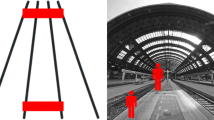Abstract
Although it is obvious that vision plays a primary role in reaching and grasping objects, the sources of the visual information used in programming and controlling various aspects of these movements is still being investigated. One source of visual information is feedback relating to the characteristics of the reach itself – for example, the speed and trajectory of the moving limb and the change in the posture of the hand and fingers. The present study selectively eliminated this source of visual information by blocking the subject’s view of the reaching limb with an opaque barrier while still enabling subjects to view the goal object. Thus, a direct comparison was made between standard (closed-loop) and object-only (open-loop) visual-feedback conditions in a situation in which the light levels and contrast between an object and its surroundings were equivalent in both viewing conditions. Reach duration was longer with proportionate increases in both the acceleration and deceleration phases when visual feedback of the reaching limb was prevented. Maximum grip aperture and the proportion of movement time at which it occurred were the same in both conditions. Thus, in contrast to previous studies that did not employ constant light levels across closed- and open-loop reaching conditions, a dissociation was found between the spatial and temporal dimensions of grip formation. It appears that the posture of the hand can be programmed without visual feedback of the hand – presumably via a combination of visual information about the goal object and proprioceptive feedback (and/or efference copy). Nevertheless, maximum grip aperture (like the kinematic markers examined in the transport component) was also delayed when visual feedback of the reaching limb was selectively prevented. In other words, the relative timing of kinematic events was essentially unchanged, reflecting perhaps a tight coupling between the transport and grip components.
Similar content being viewed by others
Author information
Authors and Affiliations
Additional information
Received: 3 July 1998 / Accepted: 18 November 1998
Rights and permissions
About this article
Cite this article
Connolly, J., Goodale, M. The role of visual feedback of hand position in the control of manual prehension. Exp Brain Res 125, 281–286 (1999). https://doi.org/10.1007/s002210050684
Issue Date:
DOI: https://doi.org/10.1007/s002210050684




